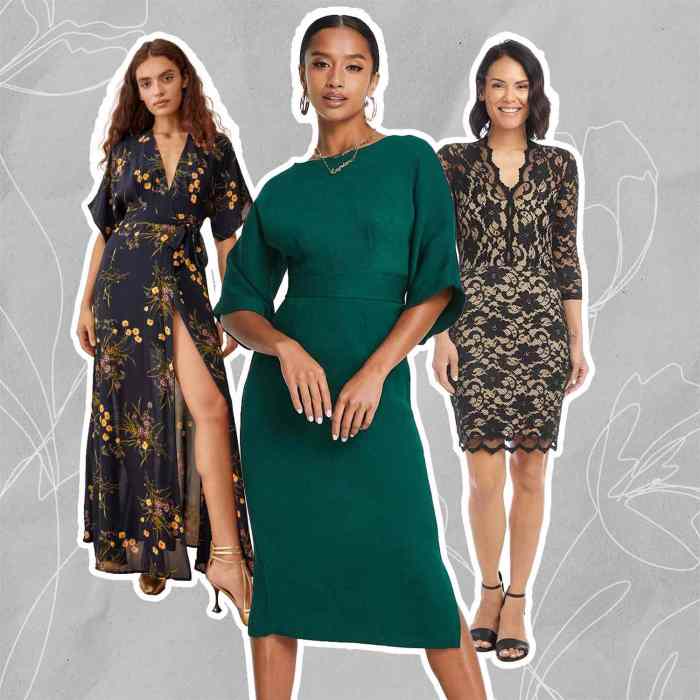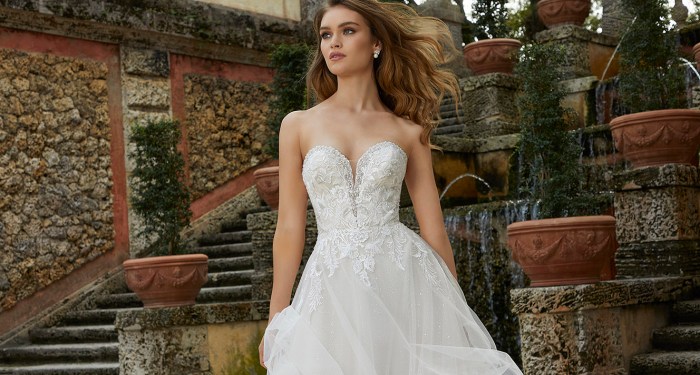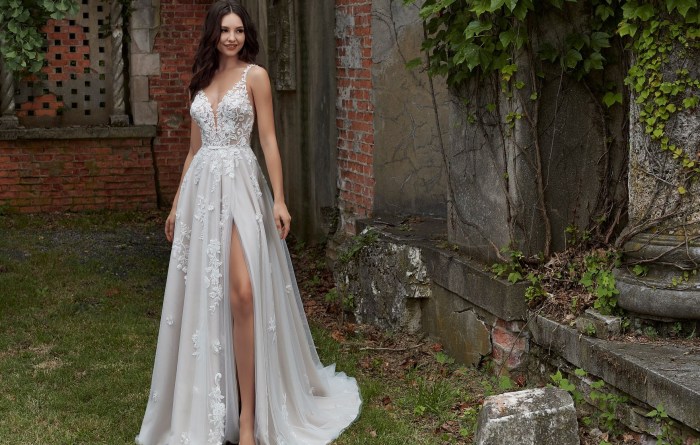Finding the Perfect Silhouette
Wedding dresses for shorter brides – Choosing the right silhouette is crucial for shorter brides, as it significantly impacts how their figure is perceived. The goal is to create a visually lengthening effect, emphasizing the bride’s best features and minimizing any perceived shortness.
Flattering Silhouettes for Shorter Brides

Source: brides.com
Several silhouettes are particularly flattering on shorter brides. A-line dresses, with their gently flared skirt, create a balanced and graceful look, elongating the body. Empire waist dresses, cinching just below the bust, emphasize the waist and create a flowing silhouette that can add height. Sheath dresses, while more form-fitting, can be very elegant and flattering if chosen in the right fabric and length, especially when paired with heels.
Avoid ball gowns or overly full skirts, as these can overwhelm a shorter frame.
Neckline Choices for Enhancing Appearance
The neckline also plays a vital role. V-necklines create a vertical line, drawing the eye downwards and adding a sense of length. Sweetheart necklines, with their gentle curve, offer a romantic touch while still being flattering. Halter necklines can be very chic and create a clean, elongated line. High necklines might shorten the neck, so it’s generally advisable to avoid them unless paired with a very strategically chosen silhouette and accessories.
Comparing A-line, Empire Waist, and Sheath Dresses
While all three silhouettes—A-line, empire waist, and sheath—can be flattering, they offer different advantages. A-line dresses provide a universally flattering shape and are easy to accessorize. Empire waist dresses are ideal for highlighting the upper body and creating a flowing silhouette. Sheath dresses offer a more streamlined and sophisticated look, best suited for brides with a confident and well-defined figure.
Using Dress Details for a Lengthening Effect
Strategic use of details can significantly enhance the visual impact. A well-placed belt at the natural waist can define the figure and create a more proportional look. Vertical embellishments, like beading or lace detailing that runs down the dress, can create a lengthening effect. Avoid overly horizontal details, which can visually shorten the body. A subtle train can add elegance without overwhelming the figure.
Silhouette Suitability for Shorter Brides
| Silhouette | Description | Pros | Cons |
|---|---|---|---|
| A-line | Gently flared skirt | Flattering, versatile, easy to accessorize | Can be less dramatic than other styles |
| Empire Waist | Cinched just below the bust | Elongates the body, emphasizes upper body | Might not suit all body types |
| Sheath | Form-fitting | Streamlined, sophisticated | Requires a confident figure, might not be as forgiving |
| Mermaid/Trumpet | Fitted bodice, flared skirt from knees | Creates curves, adds drama | Can be less flattering if not fitted perfectly |
Fabric and Texture Considerations
Fabric choice significantly impacts the overall look and feel of the wedding dress. Certain fabrics create a more streamlined and elegant appearance, while others can overwhelm a shorter frame. Careful consideration of texture can add visual interest without compromising the overall effect.
Impact of Different Fabrics
Lightweight fabrics like chiffon and silk create a flowing, ethereal look, which can be very flattering on shorter brides. Lace adds texture and visual interest without adding bulk. Satin, while elegant, can sometimes cling too much, so it’s crucial to choose the right style and cut. Heavier fabrics like brocade or heavily embellished fabrics might overwhelm a smaller frame.
Choosing Fabrics for a Streamlined Appearance
For a streamlined and elegant look, opt for fabrics that drape well and flow gracefully. Avoid stiff fabrics that add bulk or create unwanted volume. The right fabric choice can help create a longer, leaner silhouette. Consider fabrics with a subtle sheen, as this can enhance the overall elegance.
Using Textures to Add Visual Interest
Textures can add visual interest without adding bulk. Lace, for example, can add a romantic touch without overwhelming the figure. Embroidery and beading can be used sparingly to add detail without detracting from the overall silhouette. Avoid overly busy or textured fabrics, as these can be visually distracting.
Less Suitable Fabrics for Shorter Brides
Heavier fabrics like taffeta or thick brocade can add bulk and shorten the appearance. Fabrics with large, bold patterns can also be visually overwhelming. Avoid fabrics that are too stiff or structured, as they can make the dress appear boxy.
Recommended and Less Recommended Fabrics
- Recommended: Chiffon, silk crepe, charmeuse, lace (lightweight), crepe georgette. These fabrics drape well, create a streamlined silhouette, and are generally lightweight and breathable.
- Less Recommended: Taffeta (heavy), brocade, thick satin, heavily embellished fabrics. These can add bulk, appear heavy, and potentially overwhelm a shorter frame.
Heels and Accessories: Wedding Dresses For Shorter Brides
The right shoes and accessories can significantly impact the overall look and proportion, enhancing a shorter bride’s height and creating a balanced, stylish appearance.
Choosing Appropriate Heel Heights and Styles
Heels are a must for shorter brides, but the height and style should complement the dress. Stilettos create a long, lean line, while wedges offer comfort and stability. Avoid overly chunky heels, which can shorten the leg line. The heel height should be comfortable and practical for the entire wedding day.
Accessories for Overall Look and Proportion
Accessories can be used to draw attention upward and create a balanced look. A delicate necklace or earrings can draw the eye upwards, creating a sense of length. A long, flowing veil can also add height and elegance. Avoid accessories that are too bulky or overwhelming, as these can detract from the overall look.
Using Accessories to Draw Attention Upward
Strategically placed accessories can create a visually lengthening effect. A statement necklace or earrings can draw the eye upward, away from the lower body. A well-placed belt can define the waist and create a more balanced proportion. Vertical lines created by accessories can further enhance the lengthening effect.
Minimizing Emphasis on Height with Accessories

Source: cloudfront.net
While aiming to enhance height, it’s important to avoid accessories that might disproportionately draw attention to the bride’s height. Overly long veils, for instance, while potentially elegant, could have the opposite effect. Careful selection of accessory size and placement ensures a balanced, cohesive bridal look.
Accessories for a Visually Lengthening Effect
- Delicate necklace
- Long, flowing earrings
- Long, simple veil
- A well-placed belt at the natural waist
- High-heeled shoes (stilettos or wedges)
Visual Examples and Style Inspiration
Several dress styles are particularly flattering on shorter brides. The key elements contributing to their success are often a streamlined silhouette, strategic use of fabric and embellishments, and well-chosen accessories.
Flattering Wedding Dress Styles
Style 1: A simple A-line gown in lightweight chiffon with a V-neckline. The flowing fabric creates a graceful silhouette, while the V-neck elongates the body. Minimal embellishments keep the focus on the clean lines. Paired with nude heels and delicate jewelry, this creates a timeless and elegant look.
Style 2: An empire waist gown in lace with a sweetheart neckline. The lace adds texture and interest without adding bulk, while the empire waist creates a flowing silhouette that elongates the body. A short veil and delicate earrings complete the look.
Style 3: A sheath dress in crepe with a halter neckline. The sleek silhouette is both sophisticated and flattering, while the halter neckline draws attention upward. A simple belt at the waist defines the figure, and strappy heels and a simple updo complete the look.
Detailed Descriptions of Wedding Dresses
Each of these dresses incorporates elements designed to create a visually lengthening effect. The A-line dress utilizes a flowing fabric and V-neckline, while the empire waist dress relies on the flattering cut and delicate lace. The sheath dress emphasizes a streamlined silhouette and a clean neckline. All three styles avoid overly fussy details or heavy fabrics that might overwhelm a shorter frame.
Bridal Looks Complementing the Dresses, Wedding dresses for shorter brides
The A-line dress is complemented by a soft, romantic updo and natural makeup. The lace dress pairs well with a more elaborate updo and slightly more dramatic makeup. The sheath dress is best suited to a sleek, sophisticated updo and a clean, modern makeup look. In each case, the hair and makeup styles enhance the overall aesthetic of the dress and the bride’s features.
Shopping and Alterations

Source: cloudfront.net
Finding the perfect wedding dress requires careful planning and attention to detail, especially for shorter brides. Alterations are crucial to ensure the dress fits perfectly and enhances the overall appearance.
Tips for Finding the Perfect Wedding Dress
Start by researching different silhouettes and fabrics to determine what will be most flattering. Bring a supportive friend or family member for their opinion. Be open to trying on different styles, even those you might not have initially considered. Don’t be afraid to ask questions and seek advice from the bridal consultant. Most importantly, choose a dress that makes you feel confident and beautiful.
Finding the perfect wedding dress is crucial for shorter brides, often requiring careful consideration of silhouette and length. The right style can beautifully elongate the figure. Interestingly, the current trends in contemporary wedding guest dresses offer some inspiring design elements that translate well to bridal wear, such as elegant necklines and structured bodices. Ultimately, the goal remains the same: a dress that flatters and makes the bride feel confident and radiant on her special day.
Importance of Alterations
Alterations are essential for ensuring a perfect fit and maximizing the flattering effect of the dress. Even the most beautiful dress can look ill-fitting if not altered properly. A skilled seamstress can make adjustments to the length, waistline, and other details to create a customized fit that enhances the bride’s figure.
Common Alterations for Shorter Brides
Common alterations for shorter brides include hemming the dress to the correct length, adjusting the waistline to create a more flattering silhouette, and adding or removing bust cups for a better fit. These alterations ensure the dress fits perfectly and enhances the bride’s figure.
Potential Challenges and Solutions
Shorter brides might find limited options in their size or struggle to find dresses that don’t need significant alterations. Thorough research and a willingness to consider alterations are key. Choosing a reputable bridal shop with experienced seamstresses can also alleviate many potential concerns.
FAQ
What if I don’t like the traditional wedding dress styles?
Many non-traditional styles can be adapted for shorter brides. Consider unique necklines, bold colors, or unconventional fabrics to create a look that reflects your personality.
How can I avoid looking overwhelmed by a large dress?
Choose lighter fabrics and simpler designs. Avoid excessive embellishments or heavy layers that might dwarf your frame.
Should I always wear heels with my wedding dress?
Heels are a personal choice. While they can add height, comfortable flats or low heels can also work beautifully, especially if the dress already creates a lengthening effect.
How far in advance should I start dress shopping?
Ideally, begin your search 9-12 months before your wedding to allow ample time for alterations and potential delays.
